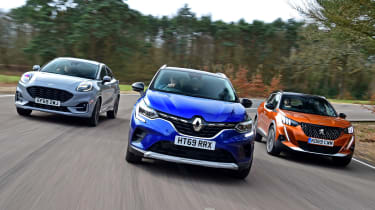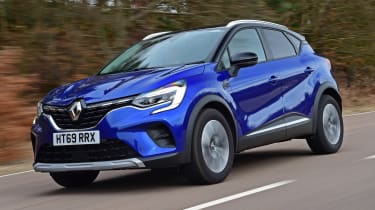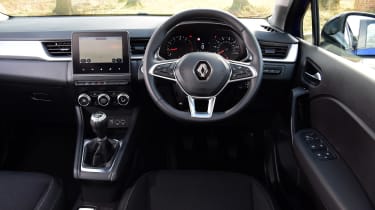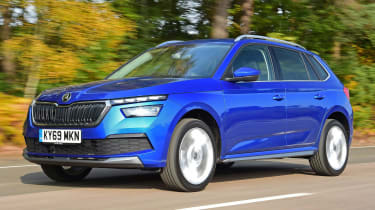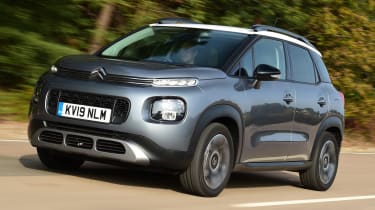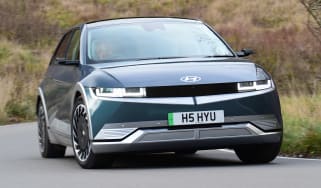Renault Captur vs Ford Puma vs Peugeot 2008
The Renault Captur, Ford Puma and Peugeot 2008 have all just been launched. We bring them together for their first Auto Express group test
The new-car market runs in cycles, so after a flurry of new superminis being launched towards the end of last year and at the start of 2020, it’s now the turn of the small SUVs to take centre stage – and we’ve rounded up three all-new models here, none of which has been through the full Auto Express road test yet.
First up is the Renault Captur. Like the French brand’s Clio supermini, this car uses new underpinnings and engines, while boasting more technology than ever, too. It’s a familiar story, and one that Ford is also writing its own chapter for with the new Puma. It’s fair to say Ford’s last effort at a small SUV, the EcoSport, was poor, so there’s a lot riding on the Puma, not least because it’s a famous nameplate for the brand and because the opposition it faces is so good.
The third of this trio is Peugeot’s new 2008. A fresh chassis and new tech mean the French model is keeping up with the pace of development, but so are its competitors, and this will be a close test because these small SUVs need to tick every box to meet the demands of buyers in this class.
Renault Captur
| Model: | Renault Captur TCe 130 Iconic |
| Price: | £20,295 |
| Engine: | 1.3-litre 3cyl turbo, 128bhp |
| 0-60mph: | 10.1 seconds |
| Test economy: | 38.0mpg/8.4mpl |
| CO2: | 127g/km |
| Annual road tax: | £145 |
As with the Clio supermini, in Iconic trim with the TCe 130 engine tested here, the £20,295 Renault Captur looks like good value for money. Let’s find out if it has the traits to support that claim.
Design & engineering
It’s no surprise that, as a small SUV, the Captur shares much tech with the smaller Clio, including the CMF-B platform this second-generation Captur has moved to adopt. The original model was based on Renault’s B platform.
The suspension set-up remains the same, with MacPherson struts at the front and a torsion-beam back axle, but this new architecture means it’s better packaged than before. It’s 110mm longer than its predecessor and looks more like an SUV, but its dimensions are still relatively compact; all three cars in this test are within 10cm of each other in length.
It’s the TCe 130 engine that we’re testing here, which is likely to be a popular choice. It’s shared with Renault’s Alliance partner Nissan and has even found its way into the Mercedes A-Class. Its 128bhp and 240Nm of torque in the Captur are fairly standard for this class, as is the six-speed manual gearbox that sends drive to the front wheels. There’s no four-wheel-drive option on any of these cars, because buyers in this class are generally more concerned with SUV style than off-road performance. This also means the level of equipment on offer for the money is a big factor for customers, and Iconic trim fares well.
It’s £3,255 cheaper than the Allure-spec 2008 and undercuts the Puma by £1,575 in ST-Line trim, yet the Renault features standard tech such as parking sensors, autonomous braking, lane-keep assist, climate and cruise control, LED headlights, sat-nav and phone connectivity. You can add a rear-view camera for £400 as part of a pack, but it’s not necessary.
One of the highlights is the interior because, as in the Clio, it feels more grown up and of a higher quality than its predecessor. The cabin doesn’t have as much design flair as the 2008’s, but the materials used in the Captur are good for the money and certainly better than the Puma’s, while the layout is functional. You could say it’s a little on the dowdy side, but otherwise there’s not much to criticise.
Driving
Given it shares much of the Clio’s make-up, it’s no surprise that it drives similarly to its supermini relative. It’s the softest of the three cars here; there’s body roll, but it’s not excessive and this forgiving set-up means the Captur is comfortable.
It’s the refinement that marks out the driving experience. The suspension soaks up bad roads quite well and while it’s clearly less dynamic than the Puma or 2008, only the worst bumps upset it, while the light steering means it’s more fun than the soft set-up would initially have you believe. It handles well enough, even if it’s not thrilling to drive. Small SUV buyers will be more concerned about comfort, and the Renault delivers plenty of this.
Its engine is a solid performer, too. The Captur and 2008 were tied on the 0-60mph sprint, both taking 10.1 seconds, while the Puma was 0.5 seconds faster. And although the Renault’s in-gear acceleration was just a few tenths behind its rivals, in most of our tests the TCe 130 motor delivers enough flexibility, despite producing the most torque.
It’s a very easy trade-off to accept given the car’s refinement, too. The engine is quiet and smooth – the other two are grumbly by comparison – and the six-speed gearbox’s shift action is fine. It’s not as nice to use as the Puma’s box, but it’s not obstructive.
Practicality
The Captur is the only car of this trio that features a sliding rear bench seat to maximise either boot space or passenger room in the rear. With the seats all the way back there’s 422 litres of boot space, which is only 12 litres less than the 2008, but 34 litres down on the Puma. Yet slide the bench forward and there are 536 litres on offer, which means the Captur is practical, even if this does significantly affect rear legroom. Set somewhere in the middle is the best compromise. Legroom is fine and headroom isn’t an issue, either.
Each door can take a 1.5-litre water bottle and there’s good storage for cups and phones – including a wireless-charging plate, which costs £155. The car is easy to get in and out of – much more so than the 2008, as we’ll see – and the boot is easy to load, too, so the Captur ticks plenty of boxes for practicality.
Ownership
Renault’s five-year/100,000-mile warranty is a strong package, and it also comes with three years’ roadside assistance. Ford and Peugeot offer three years of cover and one-year breakdown assistance.
Still, Renault’s 19th-place result in our Driver Power 2019 satisfaction survey was average. It split its two rivals, with Ford finishing 23rd and Peugeot leading these three brands in 12th place out of 30.
Where the Renault does come good again is for safety tech; autonomous braking and lane-keep assist are both fitted as standard, meaning the Captur earned a five-star Euro NCAP rating.
Running costs
The Captur falters a little on running costs. It emits the most CO2, at 127g/km, so sits in the 29 per cent Benefit-in-Kind (BiK) company car tax bracket. Despite being the cheapest car here, it’ll cost the most for business users, at £1,164 a year for lower-rate taxpayers.
The 2008 (103g/km/25 per cent) will cost £1,121 for the same driver, but it’s the mild-hybrid Ford (96g/km/23 per cent) that should be cheapest. It dips under the £1,000 BiK barrier, at £994 a year.
Testers’ notes: “We’d spend the extra and pick the TCe 130 engine. While the TCe 100 is just passable in the Clio, it’s underpowered in the Captur. It’s another £1,200, but on PCP finance won’t add much to your monthly cost.”
Ford Puma
| Model: | Ford Puma 1.0 EcoBoost Hybrid MHEV 125 ST-Line |
| Price: | £21,795 |
| Engine: | 1.0-litre 3cyl turbo, 123bhp |
| 0-60mph: | 9.6 seconds |
| Test economy: | 40.7mpg/8.9mpl |
| CO2: | 96g/km |
| Annual road tax: | £145 |
Introduced on the compact coupé of the nineties, the Puma name has been repurposed here for Ford’s latest small SUV – but the brand promises it will still be dynamic to drive. We’re testing the £21,795 Puma 1.0 EcoBoost 125 MHEV in ST-Line trim to test that claim.
Design & engineering
The Puma is based on Ford’s global B-car small car platform; this also underpins the brand’s Fiesta supermini, which is great to drive. The Puma uses Ford’s 1.0-litre three-cylinder EcoBoost turbo engine, only here it’s been given mild-hybrid tech to improve efficiency.
There’s a non-mild-hybrid version, too, which is £300 cheaper, but it seems a no-brainer to opt for this 48-volt electrically assisted tech given the low cost and improved efficiency potential.
The Puma can’t be driven on electric power alone, but its 11.5kW belt-starter generator and small lithium-ion battery provide a boost for the engine of up to 50Nm of torque, helping to improve efficiency by almost 10 per cent, according to Ford. A quick glance at the CO2 figures shows the MHEV emits 96g/km, while the standard car is 103g/km. There’s 123bhp on tap and 210Nm of torque, so the Puma’s output is the lowest here. Its claimed kerbweight of 1,280kg is also the heaviest of our three competitors.
The Ford’s interior doesn’t feel as upmarket or quite as spacious in the front as its rivals’. It seems like a smaller car from the driver’s seat, but ST-Line trim broadly matches the Captur Iconic for equipment.
Parking sensors, safety tech to match the Renault, cruise control, wireless charging, Apple CarPlay and Android Auto, plus a full digital dash are all standard, but you only get air-conditioning; climate control isn’t available as an option. The Puma’s plastics are harder than the Renault’s in a few key places, too, but the driving position definitely feels sportier while there’s a great level of adjustment in the seat and steering wheel, a typical Ford trait.
Driving
The Puma is easily the best to drive and the most fun car for handling in this test. The steering is surprisingly light given Ford’s usually heftier set-ups, but the Puma has the most grip and this light weight to the steering does at least mean you can flick it through corners nicely for a higher-riding car.
At higher speeds through bends on country roads the chassis has the most composure and ability. It’s engaging to drive, because the six-speed gearbox encourages you to work it and the engine harder.
There’s enough performance despite the engine’s power deficit, because the Puma was actually quickest from 0-60mph, taking 9.6 seconds. The Ford’s in-gear figures were also good, but there was less to separate it and its rivals in these tests.
The mild-hybrid system’s boost is just noticeable, but mainly because there is a slight hiccup in performance as it chimes in and out. It’s not a big issue, but the motor certainly isn’t as refined as the Captur’s, because it’s more vocal under load.
Despite its sharper edge when it comes to handling, the Puma is still relatively comfortable, because the suspension has been nicely set up. The damping is the best of the three cars here and it does have a decent level of compliance as a result. It’s more than smooth enough for most buyers’ needs.
Practicality
One massive positive for the Puma is its 68-litre ‘MegaBox’. This is a plastic compartment beneath the boot floor that you can use to store muddy boots or wet clothes, for example, fulfilling the lifestyle brief. It also has a drain plug so you can hose it out. Plus the MegaBox means you can stand a golf bag upright in the Puma’s boot, claims Ford, so it’s a clever solution to storage.
There’s a total of 456 litres on offer with the rear seats up, which is a generous amount even if this is less than the Renault’s maximum. However, there certainly is less room in the rear when compared with the Captur. Passengers in the rear sit higher up, which brings your legs back towards the seat base and effectively creates more legroom, so while the seating position might not be as comfortable as the Captur’s, there’s enough space.
Ownership
The level of safety kit on offer in ST-Line trim matches what the Captur and 2008 offer in their respective specs, with the Ford featuring autonomous braking with collision warning and lane-keep assist, plus lane-departure warning as standard. Unlike the Renault, you can add blind-spot warning as part of a £900 pack that also brings adaptive cruise control and a reversing camera, among other features.
Ford’s result in our Driver Power 2019 ownership survey wasn’t quite as solid; the firm finished 23rd out of 30 manufacturers and the lowest of this trio.
Running costs
Many people looking at cars like these will buy on finance, but if you’re a cash purchaser then the Puma’s predicted residual value means it’ll lose less money.
Our experts expect it to retain 52.3 per cent of its purchase price after three years or 36,000 miles, which works out at depreciation of £10,394.
The Captur is predicted to hold onto the least amount of these three, at 47.3 per cent, but because it’s also the cheapest initially, depreciation on the Renault over the same period works out at £10,695.
A predicted residual value of 49.2 per cent sees the 2008 split its competitors, but its list price is quite a bit more expensive than the Captur’s in particular, so will lose £11,975 over the same ownership period.
Testers’ notes: “You really get a sense that Ford’s fun factor has been injected into the Puma when it comes to the driving. However, the packaging isn’t as good as the Renault’s, and this is often what SUVs are bought on.”
Peugeot 2008
| Model: | Peugeot 2008 1.2 PureTech 130 Allure |
| Price: | £23,550 |
| Engine: | 1.2-litre 3cyl turbo, 129bhp |
| 0-60mph: | 10.1 seconds |
| Test economy: | 38.5mpg/8.5mpl |
| CO2: | 103g/km |
| Annual road tax: | £145 |
This second-generation 2008 is all-new, like its rivals in this test. It takes plenty of inspiration from its 208 supermini sibling, which we know is a good car, so how does this small SUV compare with its two rivals here? We’re testing a 1.2 PureTech 130 in Allure trim (our images show a GT Line) to find out.
Design & engineering
At £23,550 for this model, the Peugeot is pricier than its competition, to the tune of £3,255 in the Captur’s case and £1,575 when it comes to the Puma. Yet Allure specification doesn’t really get any more equipment than its rivals, with highlights such as nav and phone connectivity as part of its seven-inch touchscreen, a digital dash, LED headlights, plus climate and cruise control all present on the list of kit fitted as standard.
However, you do feel where that extra cash goes when it comes to the cabin and how well integrated everything is. It’s the smartest interior of the three cars, with more interesting surfaces and design elements, plus fairly high-quality materials that certainly rival the Captur’s plastics and fabrics.
It feels much fresher than the Renault’s cabin, while the Puma is familiar because it shares much with the Fiesta, so the 2008 encapsulates the craze for compact crossovers better than its rivals when it comes to design. However, the execution of Peugeot’s second-generation i-Cockpit set-up still doesn’t quite work. The relationship between the high-set digital dash and small wheel is confused, and while it might suit some drivers, there will be more that don’t get on with this layout than the more conventional ergonomics in its test competitors.
While the interior is more unusual than the norm, the engineering underneath is fairly conventional, with Peugeot’s CMP platform underpinning the 2008, featuring a similar suspension layout to its rivals’ here.
The engine is similar, too, although at 1.2 litres the 2008’s three-cylinder turbocharged unit has more capacity than the Puma’s motor. It makes 129bhp and 230Nm of torque, so its output is competitive. There’s a six-speed manual transmission driving the front wheels.
Driving
The 2008’s small wheel and light steering give it a sense of agility to rival the Puma, but it never feels quite as planted or as reassuring as the Ford. It skips over bumps in corners just a little more, without the same level of finesse to the body control or suspension damping that its rivals possess, so while it’s not as dynamic as the Ford, it’s also not as comfortable as the Renault.
It’s small margins that separate these cars, but there is a definite character to all three and the Peugeot feels like it’s caught between two camps.
The engine is strong, though, offering lots of low-down grunt, which was highlighted by our in-gear figures where the 2008 just shaded its rivals in tests between 30 and 50mph in fourth and between 50 and 70mph in fifth.
But like the Puma, the 2008’s PureTech engine grumbles more; both of these cars highlight how quiet and refined the Captur’s motor is. The six-speed gearbox is relatively sweet, however, and compared with Peugeots of old there’s much more positivity and engagement to the shift action; it’s not quite in the Puma’s league, but it easily eclipses the Captur’s gearchange for engagement.
Practicality
While the 2008 has 434 litres of boot space with the rear seats up, splitting the Captur in its smallest set-up and the Puma with its MegaBox, offering plenty of room for four people’s luggage, there’s less space for passengers inside. The roofline feels lower, so headroom isn’t quite as good, even if legroom is still strong.
One of the major drawbacks of the 2008’s styling is that access to the rear is difficult, too. The sills are high, so you have to climb in over them more than in either rival, and to compound things the roofline is quite low, so you have to stoop a little more. Bear this in mind if you’ll be strapping children into car seats, for example, because this is usually an SUV strength.
Otherwise, despite the 2008’s funky-looking cabin there’s still a good level of storage, with cubbies, trays and bins dotted around to hold your gadgets and trinkets. It’s on par with both the Captur and Puma.
Ownership
Peugeot’s 12th-place finish in our Driver Power 2019 ownership study meant it ranked highest among owners of these three brands, with buyers praising the French manufacturer’s quality, tech and dynamic performance consistently across the board.
Safety is another strong point, because like its test rivals, it also received a five-star Euro NCAP rating thanks to autonomous braking and lane-keep assist being fitted as standard. Peugeot’s £300 Drive Assist Pack Plus adds semi-autonomous adaptive cruise, so looks like decent value for money.
Running costs
Given these three cars are of a similar power, size and weight, it’s no surprise that their fuel economy on test was alike. The 2008 split its rivals with a result of 38.5mpg, for an annual fuel cost of £1,766 at today’s fuel prices. It was the Puma that recorded the strongest efficiency, making the most of its mild-hybrid tech for a return of 40.7mpg and an annual fuel bill of £1,670.
At 38mpg, the Captur just trailed the 2008’s result, but it should only cost you an extra £44 at the pumps over an average 12 months of motoring, so running costs for the Renault are still affordable.
Testers’ notes: “Just as it does on the 208, Peugeot’s new design language looks really good on this 2008 small SUV, we think. It’s certainly a striking-looking car, which counts in this style-conscious class.”
Verdict
First place: Renault Captur
As in the Renault Clio, the Captur’s new underpinnings and technology mean it’s every bit the competitive crossover in this small SUV class – but it’s the model’s impressive value for money compared with the Puma and the 2008, along with its versatility, that promote it to first place here. Performance is fine, running costs are sound, and the level of standard equipment is strong, so the Captur looks like a great buy.
Second place: Ford Puma
In typical Ford fashion the Puma is great to drive, and some clever touches such as the MegaBox mean it’s relatively practical, even if it does lack a little rear passenger space. There’s a comparable level of kit to the Captur and the mild-hybrid engine offers a good mix of strong performance and low running costs, but it’s not quite as refined as the Renault and a little pricier, so it just loses out here.
Third place: Peugeot 2008
The 2008 has the highest-quality cabin and it’s the most interesting, but it’s significantly pricier than the Captur and doesn’t offer as much standard kit. It also lacks a little practicality and comfort, but the 2008 is a small SUV that’s packed with personality, looks great, and is good enough to drive. Its engine is punchy, too, but a bit vocal, and the gearbox is much improved compared with previous Peugeots.
Other options in this category...
Skoda Kamiq
- Model: Skoda Kamiq 1.0 TSI 115 SE L
- Price: £21,980
- Engine: 1.0-litre 3cyl, 113bhp
The Kamiq is Skoda’s entry into this class, and it’s extremely competent. It drives well, is practical and gets plenty of kit in SE L trim, but it’s a bit pricier than the Captur, even if it offers a similar level of comfort and refinement to its French competitor.
Citroen C3 Aircross
- Model: Citroen C3 Aircross PureTech 110 Flair
- Price: £20,770
- Engine: 1.2-litre 3cyl, 108bhp
It might be down on power, but in top-spec Flair trim the C3 Aircross is well equipped and has versatility to pretty much match the three cars above. The engine isn’t quite as smooth and its gearbox is baggy, but the Aircross is good value.
Figures
| Renault Captur TCe 130 Iconic | Ford Puma 1.0 EcoBoost Hybrid MHEV 125 ST-Line | Peugeot 2008 1.2 PureTech 130 Allure | |
| On the road price/total as tested | £20,295/£21,410 | £21,795/£22,545 | £23,550/£23,550 |
| Residual value (after 3yrs/36,000) | £9,600/47.3% | £11,401/52.3% | £11,575/49.2% |
| Depreciation | £10,695 | £10,394 | £11,975 |
| Annual tax liability std/higher rate | £1,164/£2,328 | £994/£1,988 | £1,121/£2,241 |
| Annual fuel cost (12k/20k miles) | £1,789/£2,981 | £1,670/£2,783 | £1,766/£2,943 |
| Insurance group/quote/VED | 14/£471/£145 | 12/£411/£145 | 18/£394/£145 |
| Cost of 1st/2nd/3rd service | £449 (3yrs) | £574 est. (3yrs) | £179/£299/£179 |
| Length/wheelbase | 4,227/2,639mm | 4,207/2,588mm | 4,300/2,605mm |
| Height/width | 1,576/1,797mm | 1,537/1,805mm | 1,550/1,770mm |
| Engine | 3cyl in-line/1,333cc | 3cyl in-line/999cc | 3cyl in-line/1,199cc |
| Peak power/revs | 128/5,000 bhp/rpm | 123/6,000 bhp/rpm | 129/5,500 bhp/rpm |
| Peak torque/revs | 240/1,600 Nm/rpm | 210/1,750 Nm/rpm | 230/1,750 Nm/rpm |
| Transmission | 6-speed man/fwd | 6-speed man/fwd | 6-speed man/fwd |
| Fuel tank capacity/spare wheel | 45 litres/repair kit | 42 litres/repair kit | 44 litres/repair kit |
| Boot capacity (seats up/down) | 422-536/1,275 litres | 456/1,216 litres | 434/1,467 litres |
| Kerbweight/payload/towing weight | 1,234/541/1,500kg | 1,280/480/1,100kg | 1,192/523/1,200kg |
| Turning circle | 11.1 metres | 10.5 metres | 10.4 metres |
| Basic warranty (miles)/recovery | 5yrs (100,000)/3yrs | 3yrs (60,000)/1yr | 3yrs (unlimited)/1yr |
| Driver Power manufacturer/dealer pos. | 19th/26th | 23rd/23rd | 12th/16th |
| NCAP: Adult/child/ped./assist/stars | 96/83/75/74/5 | 94/84/77/74/5 | 93/84/73/73/5 |
| 0-60/30-70mph | 10.1/9.3 secs | 9.6/9.9 secs | 10.1/9.6 secs |
| 30-50mph in 3rd/4th | 4.2/6.0 secs | 4.4/6.2 secs | 4.4/5.6 secs |
| 50-70mph in 5th/6th | 9.0/11.7 secs | 8.9/11.6 secs | 8.7/11.8 secs |
| Top speed/rpm at 70mph | 121mph/2,250rpm | 119mph/2,500rpm | 122mph/2,500rpm |
| Braking 70-0/60-0/30-0mph | 46.0/34.0/8.6m | 45.9/33.8/8.5m | 44.6/33.0/8.4m |
| Auto Express econ. (mpg/mpl)/range | 38.0/8.4/376 miles | 40.7/8.9/376 miles | 38.5/8.5/373 miles |
| WLTP combined | 42.8-44.1mpg | 48.7-51.4mpg | 43.7-50.6mpg |
| WLTP combined | 9.4-9.7mpl | 10.7-11.3mpl | 9.6-11.1mpl |
| Actual/claimed CO2/tax bracket | 172/127g/km/29% | 160/96g/km/23% | 170/103g/km/24% |
| Airbags/Isofix/parking sensors/cam | Eight/yes/yes/£400 | Six/yes/yes/£900* | Six/yes/yes/£200 |
| Auto box/lane-keep/blind spot/AEB | £1,600/yes/no/yes | No/yes/£900*/yes | £1,550/yes/no/yes |
| Clim./cruise ctrl/leather/heated seats | Yes/yes/no/no | Air-con/yes/no/£300* | Y/y/£1,700*/£1,700* |
| Met paint/LEDs/keyless/pwr tailgate | £560/yes/yes/no | £750/£800/no/no | £575/yes/£350/no |
| Nav/digi dash/DAB/connected services | Yes/no/yes/yes | Yes/yes/yes/yes | £650*/yes/yes/yes |
| Wireless charge/CarPlay/Android Auto | No/yes/yes | Yes/yes/yes | £120/yes/yes |
